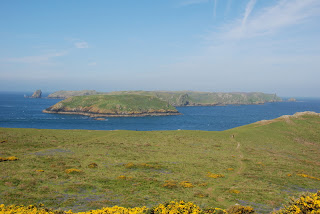


A strong breeze was blowing when we woke this morning and it still seemed to be coming from the north – not a good sign. We prepared for the trip to Skomer but also took with us details of a walk around the peninsular (obtained from the excellent Pembrokeshire Coast National Park site).
Within a few minutes we arrived at St. Martin's Haven to see that the northerly wind was blowing straight into it and the waves were pounding the beach. The National Trust shop confirmed that there would be no ferries that day and tomorrow's prospects were not good.
We set off around the promontory just beyond St. Martin's Haven. This was a very large Iron Age fort with a huge bank and ditch separating it from the mainland. Around 1800 a large stone wall was built on the land side of the bank and ditch. This was meant to convert the promontory into a deer park but no deer were ever introduced. We joined many disappointed birdwatchers walking around the headland, admiring the views over to the inaccessible Skomer and looking for the elusive Puffins. I felt very inadequate – they all had vastly more knowledge of birds than me, their binoculars were many times more powerful and as for their camera lenses, well size obviously does matter in the world of twitchers! Still we did see and identify a Chuff - a first for us – we were really chuffed!
Low tide was rapidly approaching and the sea was rushing through the Jack Sound between Skomer and the Deer Park promontory. This was a very impressive sight but unfortunately we didn't see any of the porpoises that allegedly often hunt there. The walk then took us along the coast until we came to Albion Sands well below us. Here is Gateholm Island, accessible for a couple of hours either side of low tide, an Iron Age fort with many hut circles where there have been finds of pottery and flints. With high cliffs, surrounded on three sides by the sea, all four at high tide and with three banks and ditches on the accessible side, it was wonderfully defended. On the other side of the island is the huge Marloes Sands, a glorious stretch of golden beach. We continued above the beach until the path descended and allowed us to access it. The top of the beach is covered with fascinating rock formations and, together with the gently sloping beach, it provides lots of rock pools that are only covered at high tide. The tall rocks provided plenty of locations sheltered from the cold wind and we found a suitable place for lunch. As the overgrown child that I am, I went off to investigate the rocks and the rock pools, taking my camera with me to provide an excuse.
The visit to the beach was a small diversion from the official walk but following a wide path up from the beach, we soon arrived at the National Trust Marloes Sands car park and rejoined the walk route.
The walk took us back to the bottom of the field in which we camped and sat out in the lea of the van, protecting us from that chilly northerly wind. As we sat there, we watched a bird of prey using the wind to hover over the long grass in our field looking for prey. It was a beautiful bird, a harrier of some sort, possibly a Hen Harrier? Why is it that birds never look the same in the bird books as they do in the flesh?
Photos: Skomer Island from the high point of the Iron Age hill fort in the Deer Park; They have intelligent sheep in Wales (the sign reads “Sheep have worked out how to use a kissing gate!!!! Please place loop over gate.”); The rock formations on Marloes Sands with Gateholm Island and Skokholm Island in the background.
No comments:
Post a Comment